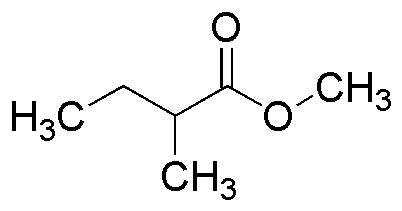Methyl 2-methylbutyrate is widely utilized in research focused on:
- Flavor and Fragrance Industry: This compound is commonly used as a flavoring agent in food products and beverages, providing a fruity aroma reminiscent of apples and berries, enhancing the sensory experience for consumers.
- Solvent Applications: It serves as an effective solvent in the formulation of paints, coatings, and adhesives, improving the application properties and drying times compared to traditional solvents.
- Pharmaceuticals: Methyl 2-methylbutyrate is used in the synthesis of various pharmaceutical compounds, aiding in the development of medications with improved efficacy and reduced side effects.
- Cosmetics: This chemical is incorporated into cosmetic formulations for its pleasant scent and potential skin-conditioning properties, making products more appealing to consumers.
- Research and Development: In academic and industrial research, it is utilized as a reagent in organic synthesis, enabling the creation of complex molecules and facilitating advancements in chemical research.
General Information
Properties
Safety and Regulations
Applications
Methyl 2-methylbutyrate is widely utilized in research focused on:
- Flavor and Fragrance Industry: This compound is commonly used as a flavoring agent in food products and beverages, providing a fruity aroma reminiscent of apples and berries, enhancing the sensory experience for consumers.
- Solvent Applications: It serves as an effective solvent in the formulation of paints, coatings, and adhesives, improving the application properties and drying times compared to traditional solvents.
- Pharmaceuticals: Methyl 2-methylbutyrate is used in the synthesis of various pharmaceutical compounds, aiding in the development of medications with improved efficacy and reduced side effects.
- Cosmetics: This chemical is incorporated into cosmetic formulations for its pleasant scent and potential skin-conditioning properties, making products more appealing to consumers.
- Research and Development: In academic and industrial research, it is utilized as a reagent in organic synthesis, enabling the creation of complex molecules and facilitating advancements in chemical research.
Documents
Safety Data Sheets (SDS)
The SDS provides comprehensive safety information on handling, storage, and disposal of the product.
Product Specification (PS)
The PS provides a comprehensive breakdown of the product’s properties, including chemical composition, physical state, purity, and storage requirements. It also details acceptable quality ranges and the product's intended applications.
Certificates of Analysis (COA)
Search for Certificates of Analysis (COA) by entering the products Lot Number. Lot and Batch Numbers can be found on a product’s label following the words ‘Lot’ or ‘Batch’.
*Catalog Number
*Lot Number
Certificates Of Origin (COO)
This COO confirms the country where the product was manufactured, and also details the materials and components used in it and whether it is derived from natural, synthetic, or other specific sources. This certificate may be required for customs, trade, and regulatory compliance.
*Catalog Number
*Lot Number
Safety Data Sheets (SDS)
The SDS provides comprehensive safety information on handling, storage, and disposal of the product.
DownloadProduct Specification (PS)
The PS provides a comprehensive breakdown of the product’s properties, including chemical composition, physical state, purity, and storage requirements. It also details acceptable quality ranges and the product's intended applications.
DownloadCertificates of Analysis (COA)
Search for Certificates of Analysis (COA) by entering the products Lot Number. Lot and Batch Numbers can be found on a product’s label following the words ‘Lot’ or ‘Batch’.
*Catalog Number
*Lot Number
Certificates Of Origin (COO)
This COO confirms the country where the product was manufactured, and also details the materials and components used in it and whether it is derived from natural, synthetic, or other specific sources. This certificate may be required for customs, trade, and regulatory compliance.


